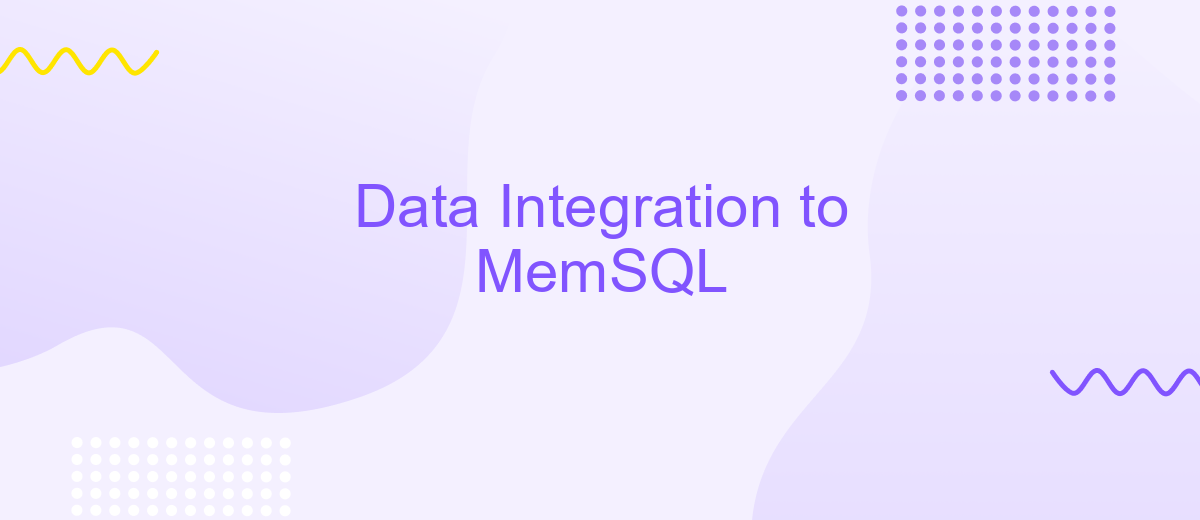Data Integration to MemSQL
Data integration into MemSQL is a crucial process for businesses seeking real-time analytics and insights. As organizations increasingly rely on diverse data sources, MemSQL offers a powerful solution for unifying and managing this information efficiently. This article explores the various methods and best practices for integrating data into MemSQL, ensuring seamless performance and enabling companies to make data-driven decisions with speed and accuracy.
Understanding Data Integration and Its Importance for MemSQL
Data integration is a critical process in modern data management, especially when dealing with high-performance databases like MemSQL. It involves combining data from various sources to provide a unified view, enabling efficient data analysis and decision-making. In the context of MemSQL, which is known for its real-time analytics capabilities, seamless data integration ensures that businesses can harness the full potential of their data, improving operational efficiency and strategic insights.
- Facilitates real-time data access and analysis.
- Enhances data accuracy and consistency across platforms.
- Supports scalability by managing diverse data sources efficiently.
- Improves decision-making by providing a comprehensive data view.
By integrating data into MemSQL, organizations can leverage its powerful in-memory processing capabilities to handle vast amounts of data swiftly. This integration not only optimizes performance but also ensures that data-driven decisions are based on the most up-to-date information. As businesses continue to evolve in a data-centric world, effective data integration with MemSQL becomes indispensable for maintaining a competitive edge.
Data Integration Methods for MemSQL (Batch, Streaming, API)

Data integration with MemSQL can be achieved through three primary methods: batch processing, streaming, and APIs. Batch processing involves the periodic collection and integration of data from various sources into MemSQL. This method is suitable for scenarios where data is not needed in real-time and can be processed in large volumes at scheduled intervals. It is particularly effective for historical data analysis and reporting. Streaming, on the other hand, enables real-time data integration, allowing businesses to capture and process data as it is generated. This method is ideal for applications requiring immediate insights, such as monitoring systems and real-time analytics.
APIs offer a flexible approach to data integration with MemSQL, providing the ability to connect and interact with various data sources programmatically. This method allows for custom integrations tailored to specific business needs. Services like ApiX-Drive can facilitate these integrations by offering pre-built connectors and a user-friendly interface to automate the data flow between systems. By leveraging these methods, organizations can ensure seamless data integration into MemSQL, enhancing their ability to make informed decisions based on comprehensive data insights.
Tools and Technologies for MemSQL Data Integration

Data integration with MemSQL, now known as SingleStore, involves utilizing a variety of tools and technologies to ensure seamless and efficient data flow. These tools facilitate the extraction, transformation, and loading (ETL) processes, enabling organizations to harness real-time analytics and insights.
- Apache Kafka: A distributed streaming platform that allows for the real-time ingestion of data into MemSQL.
- Apache Spark: A powerful analytics engine that can process large data sets and integrate directly with MemSQL for advanced analytics.
- Informatica: Provides data integration services that support ETL processes and can connect with MemSQL for data warehousing solutions.
- Talend: An open-source data integration platform that offers components and connectors for MemSQL.
- Fivetran: An automated data integration tool that offers connectors to extract data from various sources directly into MemSQL.
These technologies, among others, are essential for creating a robust data integration pipeline with MemSQL. By leveraging these tools, businesses can ensure data consistency, improve operational efficiency, and gain deeper insights from their data assets. Proper integration not only enhances data accessibility but also supports scalable analytics solutions.
Best Practices for Efficient MemSQL Data Integration

Integrating data into MemSQL efficiently requires a strategic approach to ensure optimal performance and reliability. Begin by understanding the specific data requirements and workloads to tailor the integration process accordingly. This helps in selecting the right tools and methods for data ingestion, transformation, and storage.
Next, prioritize data quality and consistency to prevent any discrepancies during the integration process. Implement robust data validation and cleansing mechanisms to maintain data integrity. Additionally, consider using parallel processing to enhance data throughput and reduce latency.
- Utilize MemSQL pipelines for real-time data ingestion to streamline the integration process.
- Leverage data compression techniques to optimize storage and improve query performance.
- Regularly monitor and tune system resources to ensure sustained performance.
- Implement data partitioning strategies to manage large datasets efficiently.
Finally, establish a robust monitoring and alerting system to quickly identify and resolve any issues that may arise during data integration. Regularly review and update integration practices to adapt to evolving data needs and technological advancements. By following these best practices, organizations can achieve seamless and efficient data integration into MemSQL.
Real-world Use Cases and Examples of MemSQL Data Integration
MemSQL, now known as SingleStore, is widely used in various real-world scenarios due to its ability to handle high-volume data integration efficiently. One prominent use case is in the financial services industry, where firms require real-time analytics to make quick decisions on trading and risk management. MemSQL's capability to process large datasets with low latency allows financial institutions to integrate data from multiple sources, providing a comprehensive view of market trends and customer behavior.
Another example is in the e-commerce sector, where companies use MemSQL to streamline their data integration processes. By leveraging tools like ApiX-Drive, businesses can automate the integration of customer data, sales transactions, and inventory levels from various platforms into MemSQL. This enables retailers to perform real-time analysis and gain insights into customer preferences, optimizing their marketing strategies and inventory management. The seamless integration capabilities of MemSQL make it a valuable asset for businesses aiming to enhance their data-driven decision-making processes.
FAQ
What is MemSQL, and why should I use it for data integration?
How can I integrate data from multiple sources into MemSQL?
What are the benefits of using an automated tool for data integration into MemSQL?
How does MemSQL handle real-time data updates during integration?
What challenges might I face when integrating data into MemSQL, and how can I address them?
Time is the most valuable resource for business today. Almost half of it is wasted on routine tasks. Your employees are constantly forced to perform monotonous tasks that are difficult to classify as important and specialized. You can leave everything as it is by hiring additional employees, or you can automate most of the business processes using the ApiX-Drive online connector to get rid of unnecessary time and money expenses once and for all. The choice is yours!

